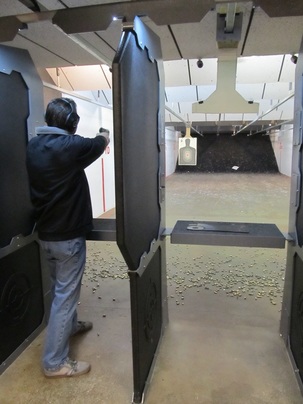 If the words “get in touch with your inner [fill in the blank]” make you want to stop reading right here, give it a sec.... in this case, getting in touch with your inner natural point of aim is something you might actually want to hear about... and try. The concept of finding your natural point of aim applies mostly to leisurely shooting. It’s helpful to know what it is, how to find it, and how it can help you to improve. The more that you’re on target from the start, the more you can focus on other elements of shooting like trigger control. Try this exercise. Imagine that you are facing your target with an unloaded firearm— position and type of gun don’t matter. You can be standing, sitting, or lying prone using a rifle, pistol or shotgun. Now, close your eyes, and raise whatever gun you have at hand to a “ready to shoot” position. Now open your eyes. Wherever your gun is pointing at the moment you open your eyes is your natural aim point. Your bones, muscles, and brain gravitated to this position based on what felt “natural.” Are the front and rear sights in the same plane or is one higher than the other? If you were holding a real gun, and aiming at a real target, most likely your sights would not be exactly where you wanted them to be. If that’s your result, you may want to try a gun with a different grip angle. The gun itself may support or work against your natural point of aim. Different handguns have different grip angles and sizes. Experiment with moving your strong side foot backward or forward from your current stance. You just might find that your sights move vertically relative to the target as you adjust your feet. Our natural tendency, when we find the sights aren’t where we want, is to push the gun and make a perfect sight alignment. Doing this works and you can hit targets, however, you’re doing more work than you need and repeatable accuracy will suffer, especially as your muscles get fatigued. Also, the process of raising your gun to a perfect sight picture will be a bit slower than if you started from a perfect natural point of aim position. To make this natural point of aim work best for you, think about moving your body parts so that the gun naturally aligns with your target without having to force it into position. Once found, the more you practice a shooting stance that embraces your natural point of aim, the more it will be programmed into your brain. When you line up to a target and raise your gun, you’ll find your body in a better position to make the shot. Of course in an emergency or dynamic shooting scenario, you’re not going to worry about finding your natural point of aim. But when you’re practicing at the range, you have the time to find the stance and position relative to the target that lines you up – naturally. When you think about it, embracing your natural point of aim is a common sense concept. So take advantage of the way your eyes and body parts naturally want to operate.
0 Comments
|
Archives
January 2018
Categories
All
|
 RSS Feed
RSS Feed
